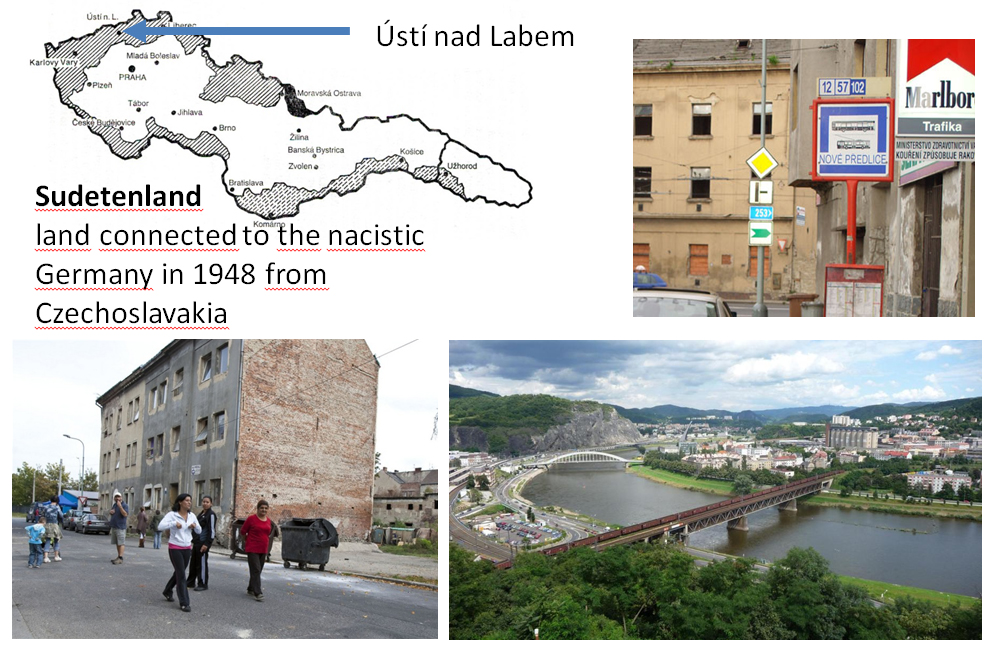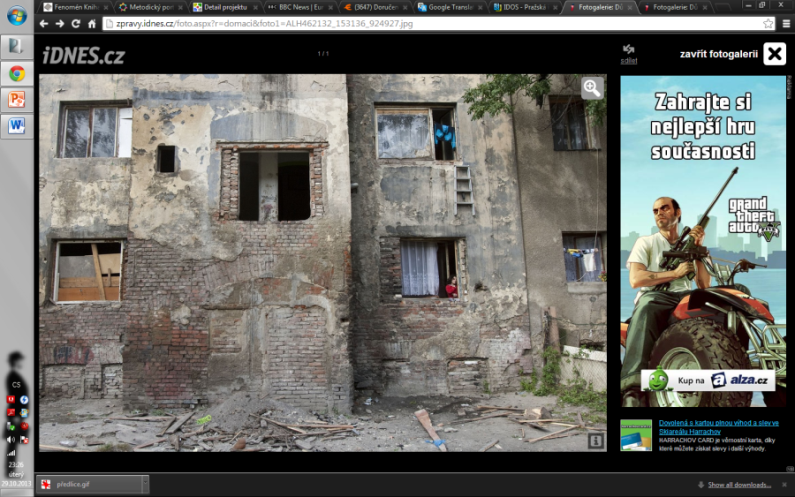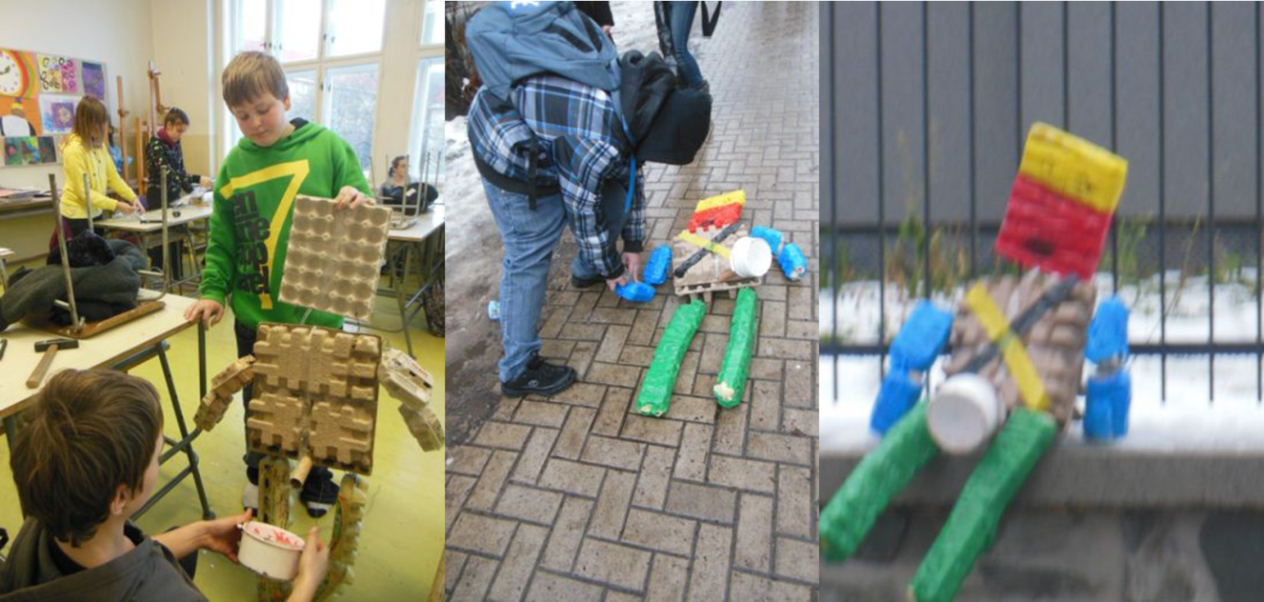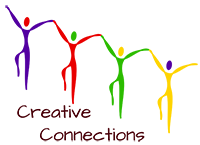ZS Palachova Elementary School - Czech Republic
Region: Ústí nad Labem
The other schools in the Quad Blog: Utsjoen saamelaislukio (Finland), Larkin Community College (Ireland), Ernest Bevin College (UK)
Creative Connections Project: My city, my space
Background
The city of Ústí nad Labem (in German: Aussig) is situated in one of the poorest regions of Czech Republic. The city with 100,000 inhabitants is situated in a mountainous district by the River Elbe, near the northern borderline with Germany. It is within one hour´s drive of Prague. There is quite a problematic social situation in this region, which accounts to its history of a ‘wild land’ and its witnessing many drastic changes in the 20th century. Ústí was a traditional German city before WWII; it was a centre of early German National Socialists. In 1938 Ústí merged with Germany as a part of Sudetenland. In 1945, the city was bombed by the Allied Forces and later another disaster (called Usti Massacre) impacted on its German inhabitants. Shortly after WWII, the town became part of Czechoslovakia again and as a consequence more than 50,000 Germans were expelled from the area. Emigrants from the Soviet Union and Romania settled in the city; especially many Roma people. After the war, Communists demolished the old buildings and built heavy industry here (e.g. a chemical factory in the city centre). Many people were forced to move to Ústí and work for the local industry without any relationship to the place. Many of the new inhabitants were of the Roma ethnicity. In the seventies and eighties the city received a new face again due to numerous newly built blocks of flats. After 1989, the city's heavy industry met serious economic troubles, which caused serious social problems. Nowadays Ústí is infamous for its segregation policy tendencies as the town is divided into ‘good’ and ‘problematic’ areas. ‘Ghettos’ are separated from the city centre by industrial areas or by railway track, thousands of people live there, more than 90% of them are of Roma origin. Socially pathological phenomena flourish and politicians are not able to improve the situation. Today´s children are often the first generation born here. They do not feel as rooted as their parents do, but they are discovering how they belong here in a very complicated process.


Palachova elementary school is a typical Czech elementary school. It is divided into first grade (for pupils from 6 to 10/11 years) and second grade (10 to 15/16 years). The first grade is focused on the basic skills of reading, writing, basic maths and general knowledge. The second grade is meant as preparation for future specialisation. Children usually continue their studies in various kinds of secondary schools. The second grade of elementary school has pejorative connotations because the ‘clever’ pupils usually leave school at the end of the first stage and attend eight years of ‘gymnasium’ (a kind of high school) which prepares them for university studies. Visual Arts Education is underestimated in the school. Teachers face problems such as lack of materials and also the pupils lack motivation. Palachova School is situated in one of the ‘best’ parts of the city, but surprisingly it borders with one of the ‘ghettos’. The population of the school is a mixture of different ethnicities and social layers. People in Ústí nad Labem seem to come from a region seemingly excluded from any interactions with Europe, but in fact, they are facing contemporary world problems every day. Social problems like intolerance, extremism, racism, discrimination, crime, poverty, unemployment and social inequality are only some of these issues. The Creative Connections project was a great opportunity for the children to feel part of Europe. It enabled them to gain confidence as European citizens. Thanks to the project the children recognized that their voice is important and can be heard, if they express it, and that they are alone in Europe.
The project
In this project called ‘My city – my space’, children from different classes from the second stage of the elementary school were involved. The project was a six month art project focused on the city of Ústí nad Labem. Pupils are examined and reflected on the place where they live: its history, neighbourhood, actual and past problems. Through the project the children learned how to express facts and their feelings about all of these issues. The major aim of the work was to build children´s identity and confidence through understanding their home city. Themes of the project were: folk costume for the 21st century; industrial architecture; legends from the region; traditional regional brands; architectural detail; landscape and its soul; fragments of the landscape; bridges of Ústí, masks; ‘strange’ people from our city; journeys in the city and where does your family come from? The project finished with an exhibition in Palachova School with a public ceremonial opening. Below we will try to describe the essence of the project through describing one specific topic, which lasted one month (this was four lessons of one and a half hours each week).
‘Strange’ people from our city
Here the teacher describes what they worked on:
Strange people live in every city across Europe. We talked about those from our town. Some of them are mentally ill, some of them are just ‘crazy’ - they wanted to be different. Some of them are very poor and maybe therefore they are doing ‘sad things’ (prostitution, drinking alcohol, taking drugs). But they belong to our society too; they belong to our town… We can observe them, we can listen to them, and we can help them or just let them be. We created the figures from different materials and then we placed them on their ‘special places’ in the street. Finally we made some photos.
- This topic was studied by a group of pupils from 8th and 9th grade (13/14 -15/16 years).
- The key issue: normality and abnormality – how to face it and reflect it?
- Discussion: How do children see socially marginalized people? What kinds do they meet in Ústí? What do children think about them and how do they feel when they meet them?
The teacher´s reflection:
We were talking about marginalized people in general and about Roma, because their ethnicity is very strong in Ústí. The majority of them are poor and they live in isolated places. I asked children about their opinion, I wanted to know if they were xenophobic or racist and what did they think about the problems. I was surprised how easily children perceived the ‘strange’ individuals around them. I expected that they would condemn them, but in fact, pupil´s opinions were rather positive. They were interested in ‘otherness’ in this context and enjoyed the topic.

Contemporary art as a space for learning: Artists used as a stimulus for themes.
After the opening discussion, the teacher showed several artworks reflecting the social issues to children and discussed them. We chose two of them for illustration:
Ladislava Gažiová: Untitled, 2005:
The artist, who is a half Roma, reflects on the unfortunate history of her ethnicity through expressive paintings containing strong emotional content. Gaziova explains:
There is a gypsy cimbalom-band in my picture, this type of gypsy music creates a very strong atmosphere, usually a bit oppressive. It is because they sing about life, which is not easy, and about love. That was the reason for the bloody rain. It is a bit strange to describe so openly. I usually leave the interpretation to the viewers, and it is not wrong when their interpretation differs from mine.
Kateřiná Šedá: Homeless, 2000:
In this piece, the artist is pictured dressed up in a coat for a homeless man. She met him near a supermarket where he lived on salami leftovers which he scratched out of salami skin. Katka and this man made friends. It was the first of her ‘larger’ socio/art projects. She did not think about it in terms of ‘making or creating Art’ at all. Her project was an attempt to utilize the salami skin and turn it into something useful - something that the homeless man lacked and needed. It is important to say that Seda respects her subject’s habits; she does not want to change his lifestyle and she is not doing any kind of social work. Seda just visited this man and they talked. Close communication and respect for a person who is radically different, one stigmatized by poverty, is an experience of ‘identity-at-a-distance’ which, in fact, is a part of understanding who we are. The coat, a belt and a bag are the project’s outcomes – Seda’s work speaks to the complexities and simplicities of social acceptance” (Comment from Creative Connections website).
The teacher´s comment:
We were talking about the socially engaged art and about the right to judge and empower these marginalized people. We were also talking about the expression of our emotions. Finally we made a little painting study about symbolic expression of our feelings through arbitrary motive.
We were also improving our technical and theoretical skills about spatial design and the possibilities which this kind of creating offers. We were talking about the significance and how is it influenced by the material used and the place where the object is installed.
Creating and reflecting
The practical task of these lessons was to create a 3D figure of an arbitrary character of marginalized person, place it in the public space of the city and take a picture of it. The pupils were working in pairs.
The teacher´s comment about the activity:
For the majority of the children it was no problem to make a 3D object. They enjoyed the work and many kinds of characters and technical solutions appeared in the class. The children were a little bit confused about the concept of installation; they understood its meaning finally during the work in the terrain around school. Finally they liked this process very much and enjoyed it, especially the photo-documentation of their installation. Some of the objects had to be moved many times, until the authors found the best place and position for it. The children were forced to think about the meanings of the places in connection with their creative intention.
I highly appreciate the children´s focus while taking the final picture of their work. They worked with composition, scale, size, blur which is another means of expression offered by photography.
Outcomes of the learning experience
This project was a significant experience for the pupils who participated in it, suddenly their work and even themselves became involved with other people´s lives. The children from Ústí nad Labem were deeply involved in the work:
- identifying who they are
- what was the meaning of the place where they live
- the history of the place and its connection with the history of their family
However, getting in touch with children abroad through the Creative Connections Quad Blogs was a bit problematic for them as there was only one computer in the class.
Finally the pupils learned much about themselves, they continued to build a relationship to the place they inhabit and they also elaborated relationships between each other. Through e-communication they gained self-confidence to introduce themselves and explain the beauty of their city despite of its problematic reputation.
Charles University in Prague, November 2013


